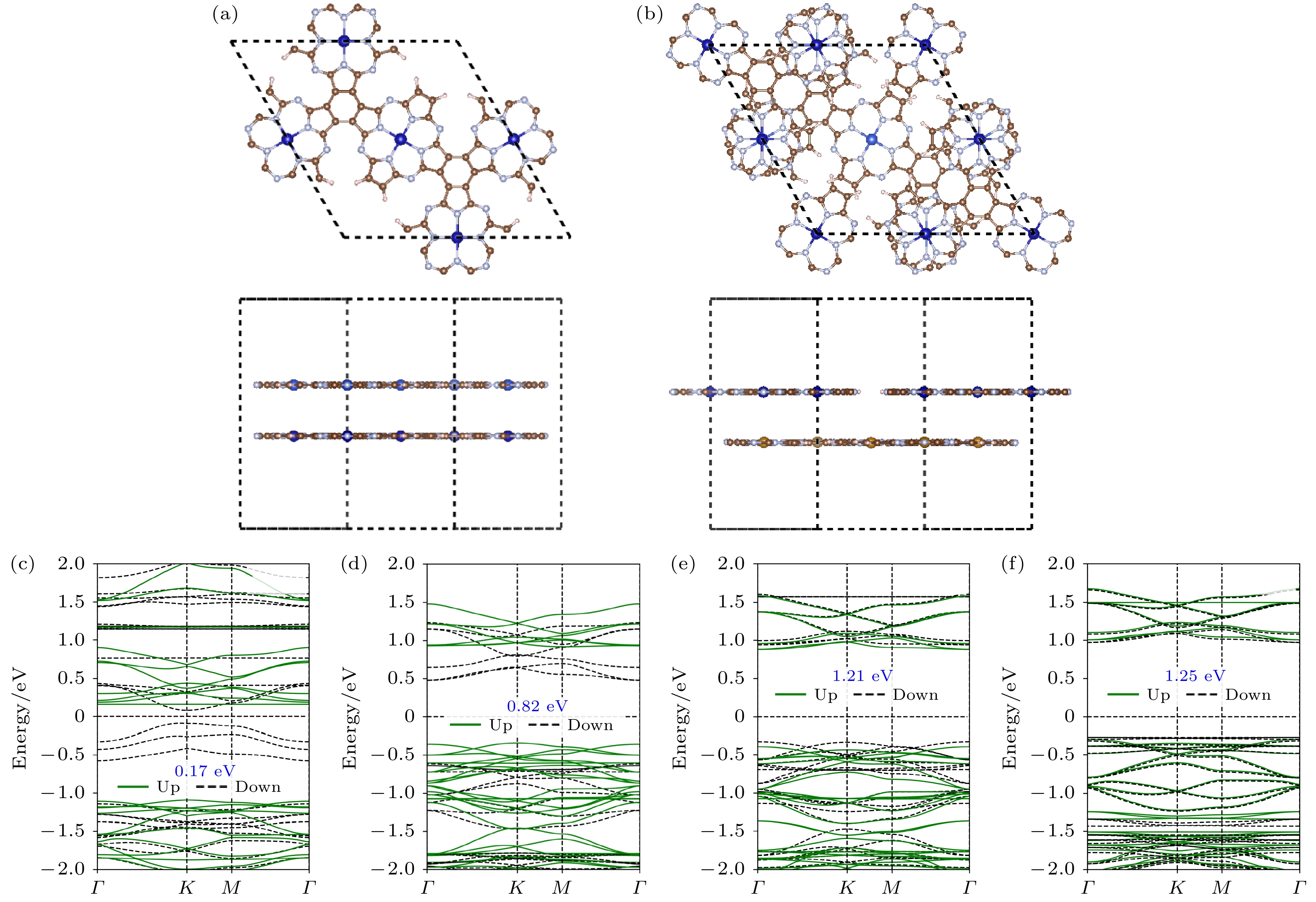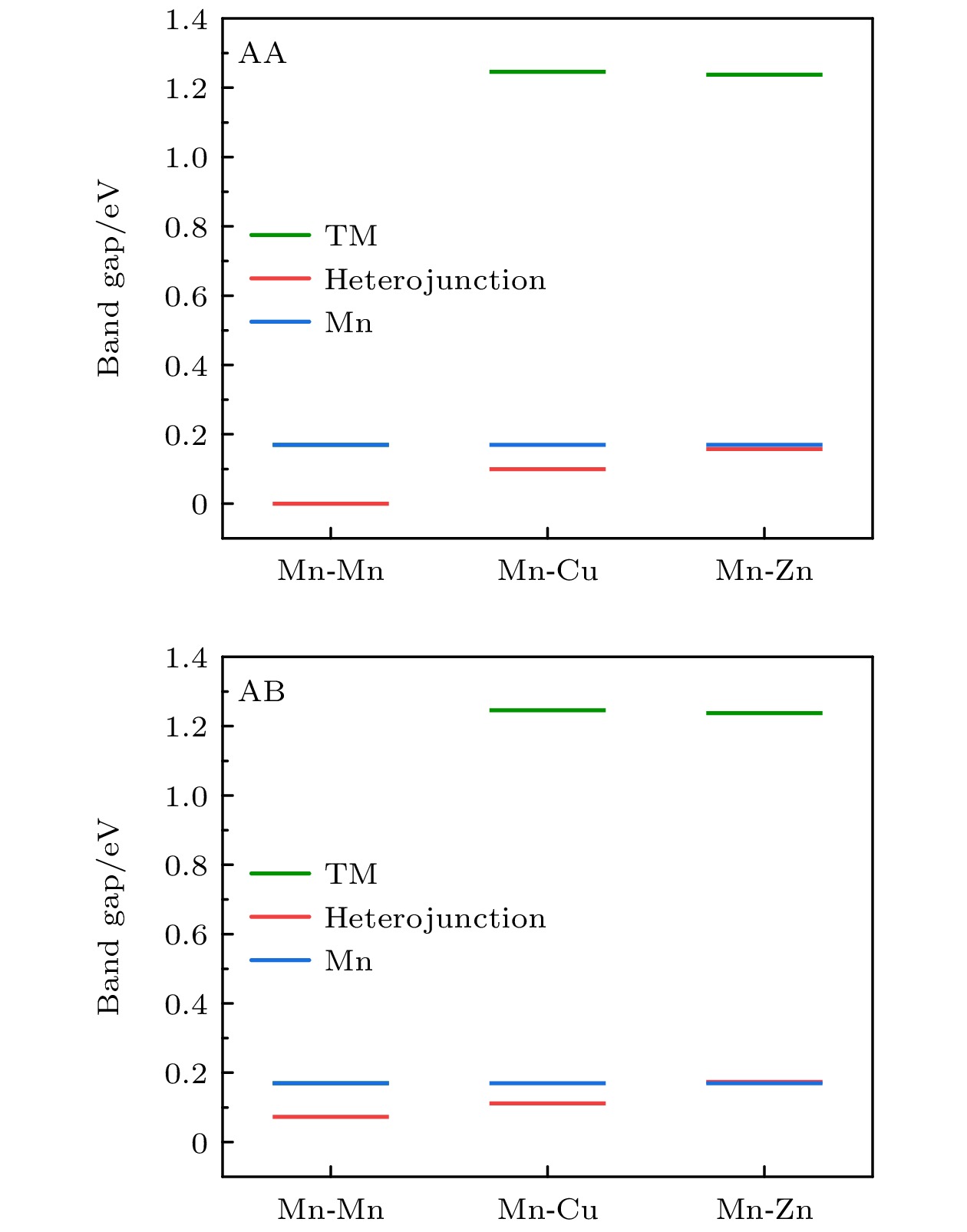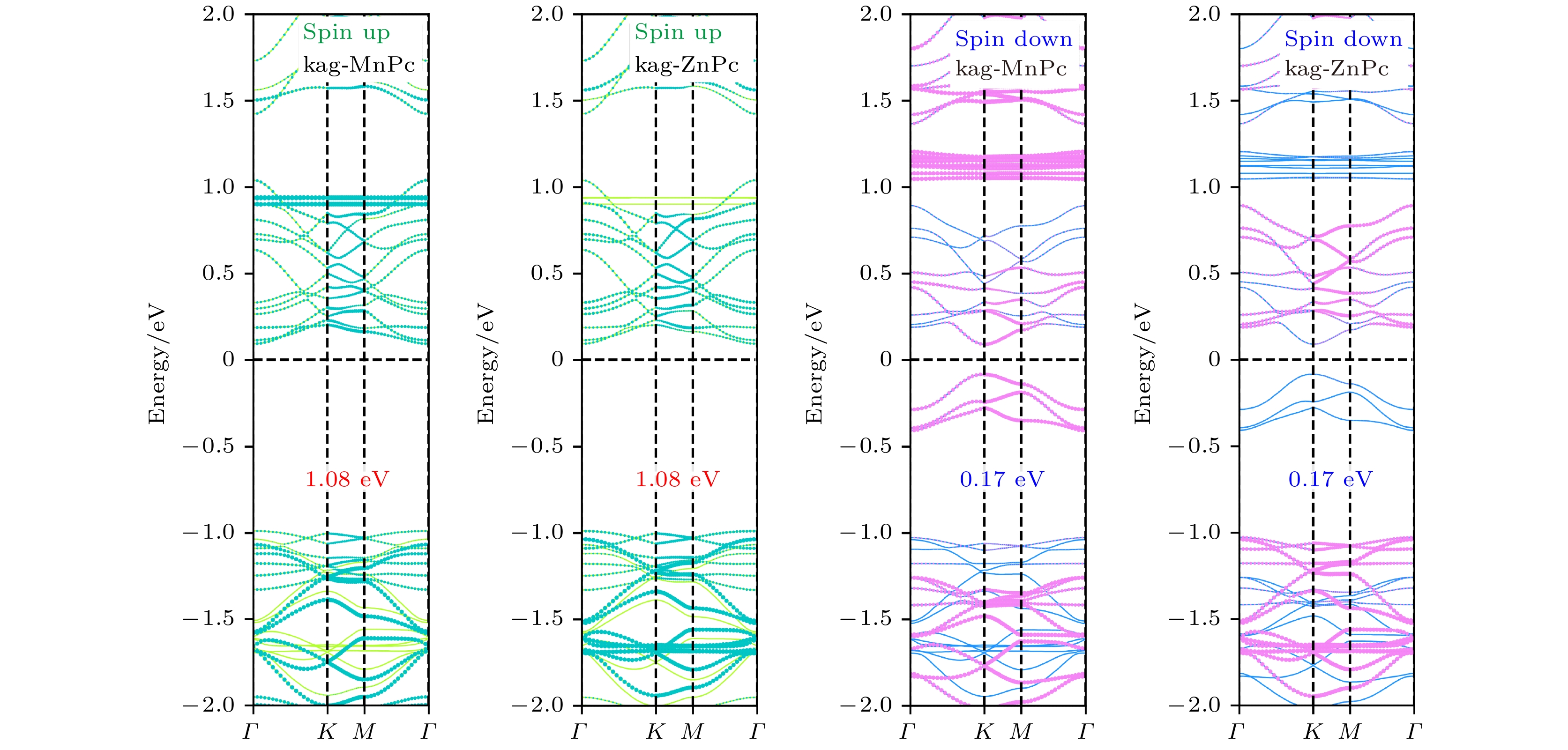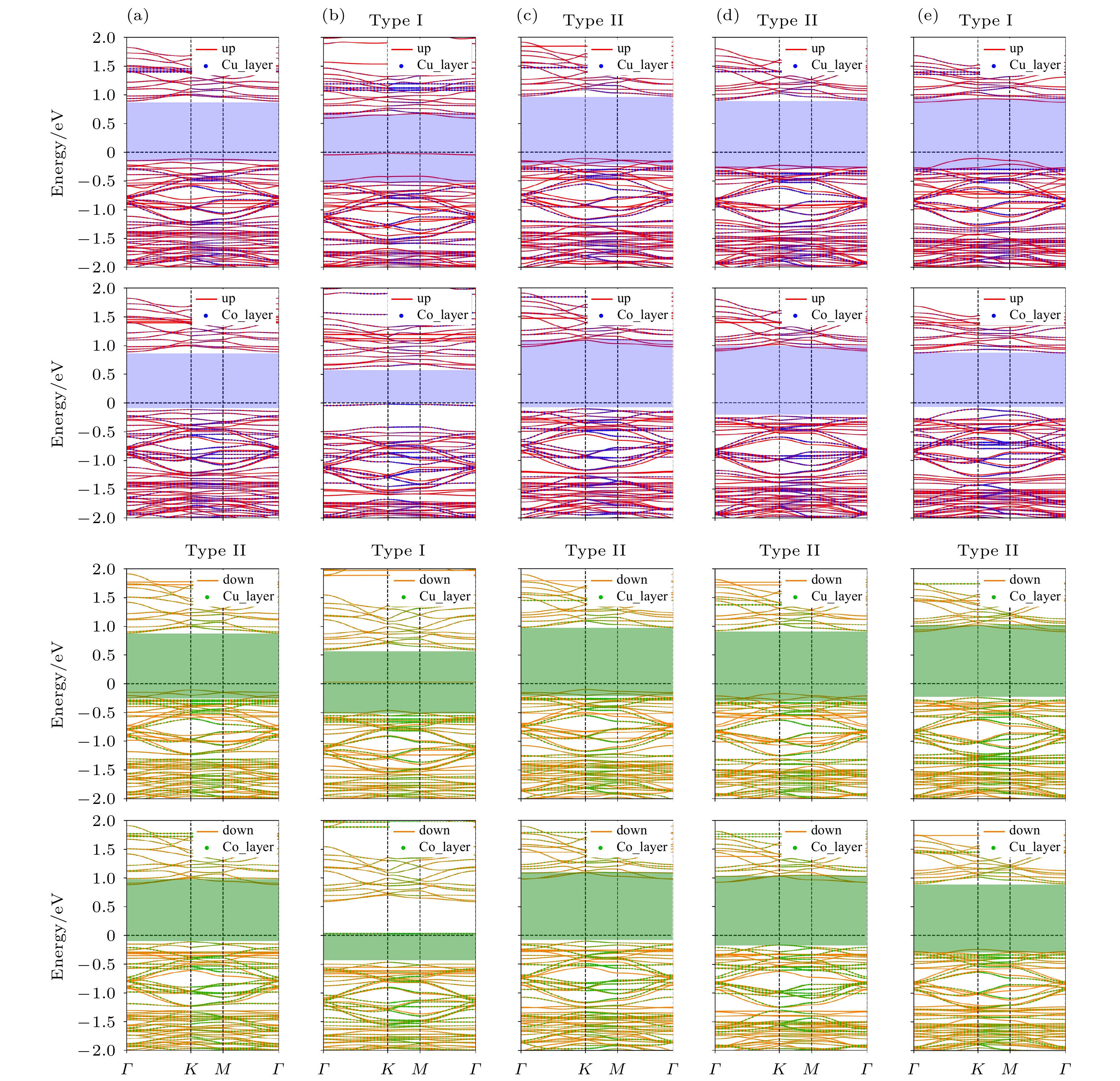-
Transition metal phthalocyanine molecules serve as building blocks for two-dimensional (2D) metal-organic frameworks with potential applications in optics, electronics, and spintronics. Previous theoretical studies predicted that a two-dimensional transition metal phthalocyanine framework with kagome lattice (kag-TMPc) has stable magnetically ordered properties, which are promising for spintronics and optoelectronics. However, there is a lack of studies on their heterojunctions, which can effectively tune the properties through interlayer coupling despite its weak nature. Here we use the density functional theory (DFT) to calculate the electronic properties of eight representative 2D kag-TMPc vertical heterojunctions with two different stackings (AA and AB) and interlayer distances. We find that most of the kag-MnPc-based heterojunctions can maintain the electronic properties of monolayer materials with low bandgap. The kag-MnPc/ZnPc is a ferromagnetic semiconductor with magnetic exchange energy above 40 meV, regardless of stacking sequences; the electronic properties of kag-MnPc/MnPc heterojunctions change from magnetic half-metal to magnetic semiconductor during the transition from AA stacking to AB stacking. Interestingly, the AB stacked kag-CuPc/CoPc heterojunction is a ferromagnetic semiconductor, and the spin-polarized energy band arrangement changes with the layer spacing: when the layer spacing is as long as the equilibrium distance, the spin-up and spin-down energy bands are aligned as type II; when the layer spacing increases by 0.2 Å, the spin-up energy bands are aligned as type-I energy bands, while the spin-down energy bands are aligned as type-II energy bands. This distance-dependent spin properties can realize magnetic optoelectronic “switching” and has potential applications in new magnetic field modulated electromagnetic and optoelectronic devices.
-
Keywords:
- magnetic material /
- heterojunction /
- first principles /
- metal organic framework
[1] Lu S, Liu L B, Demissie H, An G Y, Wang D S 2021 Environ. Int. 146 106273
 Google Scholar
Google Scholar
[2] Wei X Q, Shao D, Xue C L, Qu X Y, Chai J, Li J Q, Du Y E, Chen Y Q 2020 CrystEngComm 22 5275
 Google Scholar
Google Scholar
[3] Thorarinsdottir A E, Harris T D 2020 Chem. Rev. 120 8716
 Google Scholar
Google Scholar
[4] Van Heumen E 2021 Nat. Mater. 20 1308
 Google Scholar
Google Scholar
[5] Yang Y X, Fan W H, Zhang Q H, Chen Z X, Chen X, Ying T P, Wu X X, Yang X F, Meng F Q, Li G, Li S Y, Gu L, Qian T, Schnyder A P, Guo J G, Chen X L 2021 Chin. Phys. Lett. 38 127102
 Google Scholar
Google Scholar
[6] Zeng K Y, Song F Y, Ling L S, Tong W, Li S L, Tian Z M, Ma L, Pi L 2022 Chin. Phys. Lett. 39 107501
 Google Scholar
Google Scholar
[7] Yang Y Y, Chen K W, Ding Z F, Hillier A D, Shu L 2022 Chin. Phys. Lett. 39 107502
 Google Scholar
Google Scholar
[8] Chen H Q, Shan H, Zhao A D, Li B 2019 Chin. J. Chem. Phys. 32 563
 Google Scholar
Google Scholar
[9] Kambe T, Sakamoto R, Hoshiko K, Takada K, Miyachi M, Ryu J H, Sasaki S, Kim J, Nakazato K, Takata M, Nishihara H 2013 J. Am. Chem. Soc. 135 2462
 Google Scholar
Google Scholar
[10] Wang Z F, Su N H, Liu F 2013 Nano Lett. 13 2842
 Google Scholar
Google Scholar
[11] Abel M, Clair S, Ourdjini O, Mossoyan M, Porte L 2011 J. Am. Chem. Soc. 133 1203
 Google Scholar
Google Scholar
[12] Zhou J, Sun Q 2011 J. Am. Chem. Soc. 133 15113
 Google Scholar
Google Scholar
[13] Xu Y N, Gu Z Q, Ching W Y 2000 J. Appl. Phys. 87 4867
 Google Scholar
Google Scholar
[14] Lü K, Zhou J, Zhou L, Wang Q, Sun Q, Jena P 2011 Appl. Phys. Lett. 99 163104
 Google Scholar
Google Scholar
[15] Xie L S, Jin G X, He L, Bauer G E W, Barker J, Xia K 2017 Phys. Rev. B 95 014423
 Google Scholar
Google Scholar
[16] Ma Y D, Dai Y, Guo M, Niu C W, Huang B B 2011 Nanoscale 3 3883
 Google Scholar
Google Scholar
[17] Li X D, Yu S, Wu S Q, Wen Y H, Zhou S, Zhu Z Z 2013 J. Phys. Chem. C 117 15347
 Google Scholar
Google Scholar
[18] Dean C R, Young A F, Meric I, Lee C, Wang L, Sorgenfrei S, Watanabe K, Taniguchi T, Kim P, Shepard K L, Hone J 2010 Nat. Nanotech. 5 722
 Google Scholar
Google Scholar
[19] Lin X, Xu Y, Hakro A A, Hasan T, Hao R, Zhang B, Chen H 2013 J. Mater. Chem. C 1 1618
 Google Scholar
Google Scholar
[20] Guo L J, Hu J S, Ma X G, Xiang J 2019 Acta Phys. Sin. 68 097101
 Google Scholar
Google Scholar
[21] Kresse G, Furthmuller J 1996 Phys. Rev. B 54 11169
 Google Scholar
Google Scholar
[22] Kresse G, Furthmuller J 1996 Comp. Mater. Sci. 6 15
 Google Scholar
Google Scholar
[23] Perdew J P, Burke K, Ernzerhof M 1997 Phys. Rev. Lett. 77 3865
 Google Scholar
Google Scholar
[24] Blöchl P E 1994 Phys. Rev. B 50 17953
 Google Scholar
Google Scholar
[25] Kresse G, Joubert D 1999 Phys. Rev. B 59 1758
 Google Scholar
Google Scholar
[26] Panchmatia P M, Sanyal B, Oppeneer P M 2008 Chemical Physics 343 47
 Google Scholar
Google Scholar
[27] Bernien M, Miguel J, Weis C, Ali Md E, Kurde J, Krumme B, Panchmatia P M, Sanyal B, Piantek M, Srivastava P, Baberschke K, Oppeneer P M, Eriksson O, Kuch W, Wende H 2009 Phys. Rev. Lett. 102 047202
 Google Scholar
Google Scholar
[28] Grimme S, Antony J, Ehrlich S, Krieg H 2010 J. Chem. Phys. 132 154104
 Google Scholar
Google Scholar
[29] Ningrum V P, Liu B, Wang W, Yin Y, Cao Y, Zha C, Xie H, Jiang X, Sun Y, Qin S, Chen X, Qin T, Zhu C, Wang L, Huang W 2020 Research 2020 1768918
 Google Scholar
Google Scholar
[30] Jiang X, Jiang Z, Zhao J J 2017 Appl. Phys. Lett. 111 253904
 Google Scholar
Google Scholar
[31] Yu J T, Jiang Z, Hao Y F, Zhu Q H, Zhao M L, Jiang X, Zhao J J 2018 J. Phys. Condens. Matter 30 25LT02
 Google Scholar
Google Scholar
[32] Deng Z X, Wang X H 2019 RSC Adv. 9 26024
 Google Scholar
Google Scholar
[33] Ben Aziza Z, Pierucci D, Henck H, Silly M G, David C, Yoon M, Sirotti F, Xiao K, Eddrief M, Girard J C, Ouerghi A 2017 Phys. Rev. B 96 035407
 Google Scholar
Google Scholar
[34] Tongay S, Fan W, Kang J, Park J, Koldemir U, Suh J, Narang D S, Liu K, Ji J, Li J B, Sinclair R, Wu J Q 2014 Nano Lett. 14 3185
 Google Scholar
Google Scholar
-
图 1 AA和AB堆叠kag-TMPc异质结 (a)俯视图和(b)侧视图; (c) kag-MnPc, (d) kag-FePc, (e) kag-CoPc, (f) kag-CuPc的能带结构
Figure 1. Atomic structure of (a) AA stacking and (b) AB stacking heterostructures in kag-TMPc unit cell from a top view (upper panel) and side view (lower panel), respectively; band structures of monolayer (c) kag-MnPc, (d) kag-FePc, (e) kag-CoPc, (f) kag-CuPc.
表 1 kag-TMPc (TM = Cr, Mn, Co, Cu, Zn)的晶格常数、带隙和磁矩(MTM)
Table 1. Lattice parameters, bandgaps and magnetic moments on TM atom (MTM) of kag-TMPc (TM = Cr, Mn, Co, Cu and Zn).
Monolayer Lattice parameter/Å Bandgap/eV MTM/µB Reference[8] This work Up Down Total kag-CrPc 18.91 18.72 1.26 1.10 0.82 4 kag-MnPc 18.80 18.65 1.21 0.15 0.15 3.52 kag-CoPc 18.71 18.59 1.27 1.27 1.27 0.98 kag-CuPc 18.85 18.71 1.31 1.25 1.25 0.59 kag-ZnPc 19.03 18.82 — — 1.238 0 表 2 四类kag-TMPc异质结的晶格失配度、平衡层间距、不能堆叠方式下的能量差(ΔEheter)、层间结合能(EB)和自旋极化的能带带隙
Table 2. Lattice mismatch, equilibrium distance, energy difference between two stacking modes, interlayer binding energy, and spin-polarized bandgap of kag-TMPc heterostructures.
Heterojunction Lattice
mismatchStacking
patternEquilibrium
distance/ÅΔEheter/eV $ {E}_{{\mathrm{B}}} $/meV Bandgap/eV Up Down Total kag-MnPc/MnPc 0.00% AA 3.705 0.172 –16 0.96 0.00 0.00 AB 3.452 –17 1.08 0.07 0.07 kag-MnPc/CuPc 0.32% AA 3.591 0.005 –18 0.94 0.10 0.10 AB 3.453 –18 1.10 0.16 0.16 kag-MnPc/ZnPc 0.88% AA 3.672 0.032 –17 0.94 0.16 0.16 AB 3.448 –17 1.08 0.17 0.17 kag-CoPc/CuPc 0.64% AA 3.617 0.189 –15 0.00 0.00 0.00 AB 3.454 –16 1.08 1.08 1.08 表 3 kag-TMPc异质结的磁交换能 (ΔE)和磁矩(M)
Table 3. Exchange energies per formula (ΔE) and magnetic moments (M) for kag-TMPc heterostructures.
Heterojunction Stacking pattern ΔE/meV Magnetic property Magnetic moment MA/µB MB/µB kag-MnPc/MnPc AB 7.1 FM 3.543/3.527/3.527 3.543/3.527/3.527 kag-MnPc/ZnPc AA 42.65 FM 3.568 0 AB 43.69 FM 3.557 0 kag-CoPc/CuPc AB 240 FiM 1.05/–1.05/–1.05 0.59/–0.59/–0.59 表 4 在不同层间距下AB堆叠kag-CoPc/CuPc异质结电子结构信息
Table 4. Electronic structure parameters of AB stacking kag-CoPc/CuPc heterostructures in different interlayer distance.
Interlayer distance/Å Bandgap/eV Band alignment Spin up Spin down Total Spin up Spin down 3.254 0.990 0.990 0.990 — II 3.354 0.610 0.490 0.050 I I 3.454 1.080 1.080 1.080 II II 3.554 1.130 1.070 1.060 II II 3.654 0.970 1.150 0.970 I II -
[1] Lu S, Liu L B, Demissie H, An G Y, Wang D S 2021 Environ. Int. 146 106273
 Google Scholar
Google Scholar
[2] Wei X Q, Shao D, Xue C L, Qu X Y, Chai J, Li J Q, Du Y E, Chen Y Q 2020 CrystEngComm 22 5275
 Google Scholar
Google Scholar
[3] Thorarinsdottir A E, Harris T D 2020 Chem. Rev. 120 8716
 Google Scholar
Google Scholar
[4] Van Heumen E 2021 Nat. Mater. 20 1308
 Google Scholar
Google Scholar
[5] Yang Y X, Fan W H, Zhang Q H, Chen Z X, Chen X, Ying T P, Wu X X, Yang X F, Meng F Q, Li G, Li S Y, Gu L, Qian T, Schnyder A P, Guo J G, Chen X L 2021 Chin. Phys. Lett. 38 127102
 Google Scholar
Google Scholar
[6] Zeng K Y, Song F Y, Ling L S, Tong W, Li S L, Tian Z M, Ma L, Pi L 2022 Chin. Phys. Lett. 39 107501
 Google Scholar
Google Scholar
[7] Yang Y Y, Chen K W, Ding Z F, Hillier A D, Shu L 2022 Chin. Phys. Lett. 39 107502
 Google Scholar
Google Scholar
[8] Chen H Q, Shan H, Zhao A D, Li B 2019 Chin. J. Chem. Phys. 32 563
 Google Scholar
Google Scholar
[9] Kambe T, Sakamoto R, Hoshiko K, Takada K, Miyachi M, Ryu J H, Sasaki S, Kim J, Nakazato K, Takata M, Nishihara H 2013 J. Am. Chem. Soc. 135 2462
 Google Scholar
Google Scholar
[10] Wang Z F, Su N H, Liu F 2013 Nano Lett. 13 2842
 Google Scholar
Google Scholar
[11] Abel M, Clair S, Ourdjini O, Mossoyan M, Porte L 2011 J. Am. Chem. Soc. 133 1203
 Google Scholar
Google Scholar
[12] Zhou J, Sun Q 2011 J. Am. Chem. Soc. 133 15113
 Google Scholar
Google Scholar
[13] Xu Y N, Gu Z Q, Ching W Y 2000 J. Appl. Phys. 87 4867
 Google Scholar
Google Scholar
[14] Lü K, Zhou J, Zhou L, Wang Q, Sun Q, Jena P 2011 Appl. Phys. Lett. 99 163104
 Google Scholar
Google Scholar
[15] Xie L S, Jin G X, He L, Bauer G E W, Barker J, Xia K 2017 Phys. Rev. B 95 014423
 Google Scholar
Google Scholar
[16] Ma Y D, Dai Y, Guo M, Niu C W, Huang B B 2011 Nanoscale 3 3883
 Google Scholar
Google Scholar
[17] Li X D, Yu S, Wu S Q, Wen Y H, Zhou S, Zhu Z Z 2013 J. Phys. Chem. C 117 15347
 Google Scholar
Google Scholar
[18] Dean C R, Young A F, Meric I, Lee C, Wang L, Sorgenfrei S, Watanabe K, Taniguchi T, Kim P, Shepard K L, Hone J 2010 Nat. Nanotech. 5 722
 Google Scholar
Google Scholar
[19] Lin X, Xu Y, Hakro A A, Hasan T, Hao R, Zhang B, Chen H 2013 J. Mater. Chem. C 1 1618
 Google Scholar
Google Scholar
[20] Guo L J, Hu J S, Ma X G, Xiang J 2019 Acta Phys. Sin. 68 097101
 Google Scholar
Google Scholar
[21] Kresse G, Furthmuller J 1996 Phys. Rev. B 54 11169
 Google Scholar
Google Scholar
[22] Kresse G, Furthmuller J 1996 Comp. Mater. Sci. 6 15
 Google Scholar
Google Scholar
[23] Perdew J P, Burke K, Ernzerhof M 1997 Phys. Rev. Lett. 77 3865
 Google Scholar
Google Scholar
[24] Blöchl P E 1994 Phys. Rev. B 50 17953
 Google Scholar
Google Scholar
[25] Kresse G, Joubert D 1999 Phys. Rev. B 59 1758
 Google Scholar
Google Scholar
[26] Panchmatia P M, Sanyal B, Oppeneer P M 2008 Chemical Physics 343 47
 Google Scholar
Google Scholar
[27] Bernien M, Miguel J, Weis C, Ali Md E, Kurde J, Krumme B, Panchmatia P M, Sanyal B, Piantek M, Srivastava P, Baberschke K, Oppeneer P M, Eriksson O, Kuch W, Wende H 2009 Phys. Rev. Lett. 102 047202
 Google Scholar
Google Scholar
[28] Grimme S, Antony J, Ehrlich S, Krieg H 2010 J. Chem. Phys. 132 154104
 Google Scholar
Google Scholar
[29] Ningrum V P, Liu B, Wang W, Yin Y, Cao Y, Zha C, Xie H, Jiang X, Sun Y, Qin S, Chen X, Qin T, Zhu C, Wang L, Huang W 2020 Research 2020 1768918
 Google Scholar
Google Scholar
[30] Jiang X, Jiang Z, Zhao J J 2017 Appl. Phys. Lett. 111 253904
 Google Scholar
Google Scholar
[31] Yu J T, Jiang Z, Hao Y F, Zhu Q H, Zhao M L, Jiang X, Zhao J J 2018 J. Phys. Condens. Matter 30 25LT02
 Google Scholar
Google Scholar
[32] Deng Z X, Wang X H 2019 RSC Adv. 9 26024
 Google Scholar
Google Scholar
[33] Ben Aziza Z, Pierucci D, Henck H, Silly M G, David C, Yoon M, Sirotti F, Xiao K, Eddrief M, Girard J C, Ouerghi A 2017 Phys. Rev. B 96 035407
 Google Scholar
Google Scholar
[34] Tongay S, Fan W, Kang J, Park J, Koldemir U, Suh J, Narang D S, Liu K, Ji J, Li J B, Sinclair R, Wu J Q 2014 Nano Lett. 14 3185
 Google Scholar
Google Scholar
Catalog
Metrics
- Abstract views: 1170
- PDF Downloads: 117
- Cited By: 0















 DownLoad:
DownLoad:










